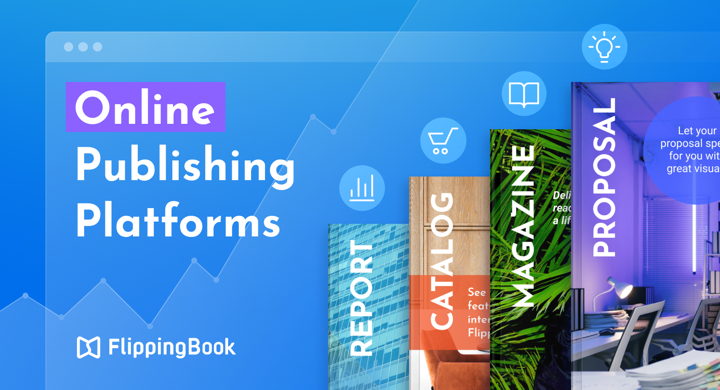Online publishing makes sharing content, connecting with your audience, and cutting production costs easier than ever. As digital publishing evolves, creators need more advanced tools to cater to expanding needs. So, to help you find the perfect software for your business, we’ve gathered a list of the best digital publishing platforms for every need.
What Is an Online Publishing Platform?
An online publishing platform is a digital service that enables publishers to create, publish, and distribute content online. These platforms support various content types, including articles, blogs, flipbooks, ebooks, and magazines.

1. FlippingBook
💡 Best for: publishing interactive flipbooks, catalogs, brochures, and ebooks
FlippingBook is a digital publishing platform that lets you create interactive content with an unrivaled, authentic reading experience. Simply upload your PDF to FlippingBook and get an online publication with a real book feel and smooth page-flip effect. Share your flipbook right away via a direct link, embed into a website, or post on social media. Give your content an engagement boost to catch your readers’ attention and stand out among competitors with captivating interactive documents.
Book a live demo to see FlippingBook in action
FlippingBook Key Benefits
🚀 Interactivity
- Turn your images into cool pop-ups or multiple image galleries that are 81% more effective in drawing attention than static content.
- Tell your story with videos and get 39% better engagement.
- Use GIFs to accentuate important points in your content, introduce infographics, or visualize difficult concepts.
- Add surveys and polls to your flipbooks to get valuable insights and connect with your audience on a deeper level.
⭐ Pro tip: Learn how to use interactivity to the fullest to supercharge your content.
🚀 Built-in lead capture form
- Collect leads right inside your flipbook with a convenient lead capture form. In fact, 90% of emails submitted through the FlippingBook lead capture form are valid.
- Customize the form to suit your needs—add fields like email, phone number, company name, country, or even create your own.
- Identify leads easily with built-in stats: all the collected lead data is organized in a handy chart. Plus, you can track lead interactions with your flipbook.
⭐ Pro tip: Check out our article on effective lead generation practices to level up your lead gen game.
🚀 Document insights and analytics
- Know how many people have read your document, how much time they’ve spent on it, and what pages are the most popular. All the content performance data is kept in one convenient dashboard.
- Share your online flipbook as a trackable individual link, track the lead’s activity with it, and contact them at the right time to close deals more quickly and efficiently.
⭐ Pro tip: Learn how to use FlippingBook’s built-in statistics to enhance your flipbooks and connect with your audience better.

2. Issuu
💡 Best for: publishing and selling magazines
Issuu is a digital magazine platform that allows you to upload PDFs, images, and text, and transform them into digital content using your own or Issuu’s layouts. Issuu is a popular choice for businesses looking to publish digital magazines and monetize their publications.
Issuu Key Benefits
🚀 Online content monetization
- Sell individual publications, such as magazines, ebooks, or reports, directly through Issuu.
- Offer subscription-based access to your content, providing a steady income stream.
- Use Issuu to distribute ad-supported content.
🚀 Articles
Articles are short, mobile-friendly pieces of content you can create from Issuu flipbooks. Optimized for small screens, they serve as a mobile-ready alternative to PDFs. Articles can be quickly shared as links or engaging social media previews.
🚀 Social posts
Create enticing social posts by using existing elements from your publications and/or uploading new assets to transform your content, and download them to share on your social channels.
⭐ Pro tip: Read more about Issuu's main features and the best Issuu alternatives you can switch to.
 3. Joomag
3. Joomag
💡 Best for: publishing simple digital content and selling subscriptions
With this online publishing platform, you can create your publication by choosing from ready designs or uploading a PDF file. This digital publishing tool provides the simplest PDF viewer, compared to other software—it has a slide mode by default, and it’s quite hard to find where to switch on the page-turning option manually.
Joomag Key Benefits
🚀 Multimedia content creation
Incorporate multimedia elements like videos, audio, interactive quizzes, feedback forms, and surveys to create engaging content. Use a drag-and-drop editor for designing interactive magazines, catalogs, and reports.
🚀 Built-in CRM
- Collect reader data through lead capture & management with gated content, subscription forms, or email sign-ups.
- Use segment audiences based on interests, engagement, or demographics.
- Sync with third-party CRM systems and email marketing platforms for streamlined customer management.
🚀 Detailed analytics
Real-time analytics allows you to track reader engagement, page views, and click-through rates. Plus, you can identify which pages or sections of a publication are most engaging.
 4. WordPress
4. WordPress
💡 Best for: creating websites with ease
WordPress is an easy-to-use online publishing platform and content management system. This digital publishing tool is known for its versatility and extensibility and is a preferred choice for many website owners and developers.
WordPress Key Benefits
🚀 Customization
WordPress offers a vast array of themes that allow you to change the website’s design and layout quickly. Plus, you can extend the functionality of your sites with thousands of plugins available.
🚀 SEO-friendly features
The website code is optimized for search engines, and various SEO plugins can enhance your site’s visibility. Many WordPress themes are responsive, making the site mobile- and SEO-friendly. You can also integrate Google Analytics plugins to track website traffic, user behavior, and key performance metrics.
🚀 E-commerce solutions
WordPress offers powerful e-commerce solutions, like WooCommerce, for creating online stores. It also supports a range of payment integrations and gateways for easy transaction processing.
⭐ Pro tip: Learn how to embed a PDF into WordPress via the FlippingBook plugin.
 5. Squarespace
5. Squarespace
💡 Best for: building websites with a drag-and-drop editor
Squarespace is a popular digital publication platform and content management system that allows individuals and businesses to create and maintain professional-looking websites. With a single subscription, you can make a website, host your content, register your own custom domain name, sell products, track your site's analytics, and much more.
Squarespace Key Benefits
🚀 Intuitive interface
Squarespace offers a user-friendly, drag-and-drop interface that makes website building simple for beginners.
🚀 E-commerce capabilities
You can sell products, services, or digital downloads with an integrated online store. Squarespace offers secure checkout, inventory management, and multiple payment options.
🚀 Robust blogging platform
- Clean and intuitive WYSIWYG (What You See Is What You Get) editor.
- Drag-and-drop functionality for adding images, videos, and text blocks.
- Supports markdown and rich text formatting for flexible writing styles.
⭐ Pro tip: Check out how you can enhance your PDF and embed it into Squarespace.
 6. StoryChief
6. StoryChief
💡 Best for: publishing blog posts
StoryChief is a content publishing platform built specifically for B2B marketing teams and content agencies, allowing them to focus on growing their business through content marketing. They can also centralize and distribute their articles and social media content to reach a wider audience and generate more leads.
StoryChief Key Benefits
🚀 Centralized content management
- Create, edit, and manage blog posts, social media updates, and newsletters in one place.
- Integrations with multiple platforms, including WordPress, Medium, HubSpot, and more.
- Multi-channel publishing to reach audiences across different platforms effortlessly.
🚀 Seamless collaboration & workflow automation
- Assign roles (writers, editors, approvers) for smooth team collaboration.
- Real-time editing and feedback to improve content quality.
- Editorial calendar to plan and schedule content efficiently.
🚀 Built-in SEO optimization
- AI-powered SEO analysis to improve search rankings.
- Keyword suggestions, readability checks, and structured data integration.
- SEO score for tracking content effectiveness before publishing.





